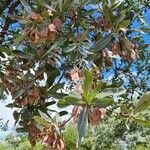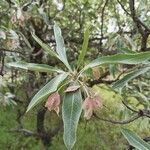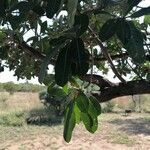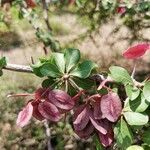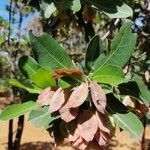Small spreading tree 3–16 m. high; bark grey-brown or pale cream, longitudinally fissured; branchlets with purplish black bark peeling off in strips to reveal a light brown newly exposed surface; young shoots sericeous-tomentose.. Leaves spirally arranged; lamina narrowly obovate-elliptic to narrowly elliptic, 5.5–12.5 cm. long, 1.5–4.5 cm. wide, apex acute to rounded, base cuneate, sericeous-pubescent to densely silvery sericeous-tomentose beneath, becoming somewhat glabrescent when old; lateral nerves 5–8 pairs, usually inconspicuous; petiole 2–10 mm. long.. Inflorescences of lateral spikes 5–7.5 cm. long; peduncle 2.5–3 cm. long, densely sericeous.. Flowers greenish white, sericeous-tomentose outside.. Fruit (fig. 12/12, p. 79) pinkish to purplish brown, broadly elliptic, 3–4 cm. long, 1.7–2.5 cm. wide, apex obtuse to rounded and usually emarginate, base obtuse to subtruncate, finely tomentose; stipe 5–7 mm. long.. Cotyledons 2, petioles 1.5–2 cm. long, arising below soil-level.
A shrub or small tree which loses its leaves during the year. It normally grows 6-9 m tall. It can grow to 23 m tall and have a stem 50 cm across. The trunk is dark and has deep splits along its length. The bark on the twigs is reddish brown due to silky hairs. The branches come out horizontal and droop slightly at the ends. This makes the branches appear to come out in layers. The leaves are clustered near the tips of the small branches. The leaves are grey-green or silver. The leaves are sword shaped and 5-15 cm long by 1.3-2.5 cm wide. They are usually wider above the middle and narrower towards the base. The leaves are on short leaf stalks. The flowers are small and yellow in spikes. They droop and have an unpleasant smell. The fruit are oval and round tipped. They are flat and with one seed. This is usually surrounded by a thin wing. The fruit become pink when ripe.
Small deciduous bushy tree or shrub, 3-12(-16) m high. Bark on young branchlets purple-black, peeling off in cylindric or hemicylindric flakes exposing reddish brown or brown surface. Leaves densely silvery sericeous-tomentose, 3 times as long as broad, lateral nerves inconspicuous. Flowers greenish white.
Leaves spirally arranged, petiolate; lamina 5·5–12·5 x 1·5–4·5 cm., chartaceous, narrowly obovate-elliptic to narrowly elliptic, densely silvery-sericeous-tomentose (somewhat glabrescent when old), apex acute to rounded, base cuneate; lateral nerves usually inconspicuous beneath; petiole 2–10 mm. long.
Small deciduous bushy tree 3–12(16) m. high or shrub; crown flat or rounded; bark grey-brown or pale-brown to grey-black, longitudinally fissured, fresh bark pale-rusty-red; branchlets with purplish-black bark peeling to reveal a light-brown newly exposed surface; young shoots sericeous-tomentose.
Fruit pinkish or purplish-brown, 3–4 x 1·7–2·5 cm. broadly elliptic, apex obtuse to rounded and usually emarginate, base obtuse to subtruncate, finely tomentose, stipe 5–7 mm. long.
Cotyledons 2, c. 2 cm. in diam., irregularly subcircular with petioles 1·5–2 cm. long, arising below soil level.
Inflorescences of lateral spikes 5–7·5 cm. long; peduncle 2·5–3 cm. long, densely sericeous.
Lower receptacle sericeous-tomentose; upper receptacle sericeous but less densely so.
Stamens 4 mm. long; anthers 0·5 mm. long.
Sepals triangular-acuminate.
Flowers greenish-white.
Disk pilose.
